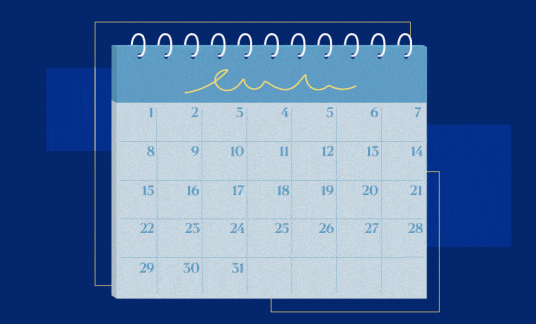It’s one thing when you’re trying to grow existing search engine optimization (SEO) rankings, and quite another when your website is losing traffic and you’ve dropped off Google entirely. Don’t panic: Most causes of a sudden drop in website traffic are completely reversible. Here are the top 10 reasons why your website is losing traffic and how to fix them.
10 Common Reasons Your Google Rankings Dropped
There are 5 main causes of SEO ranking drops, according to Google:
- Technical issues with your website or an individual page
- Security issues
- Normal seasonal fluctuations
- Manual actions (guideline violations)
- Random glitches
You can sometimes tell what’s going on by analyzing the pattern of your site traffic, such as in these examples:
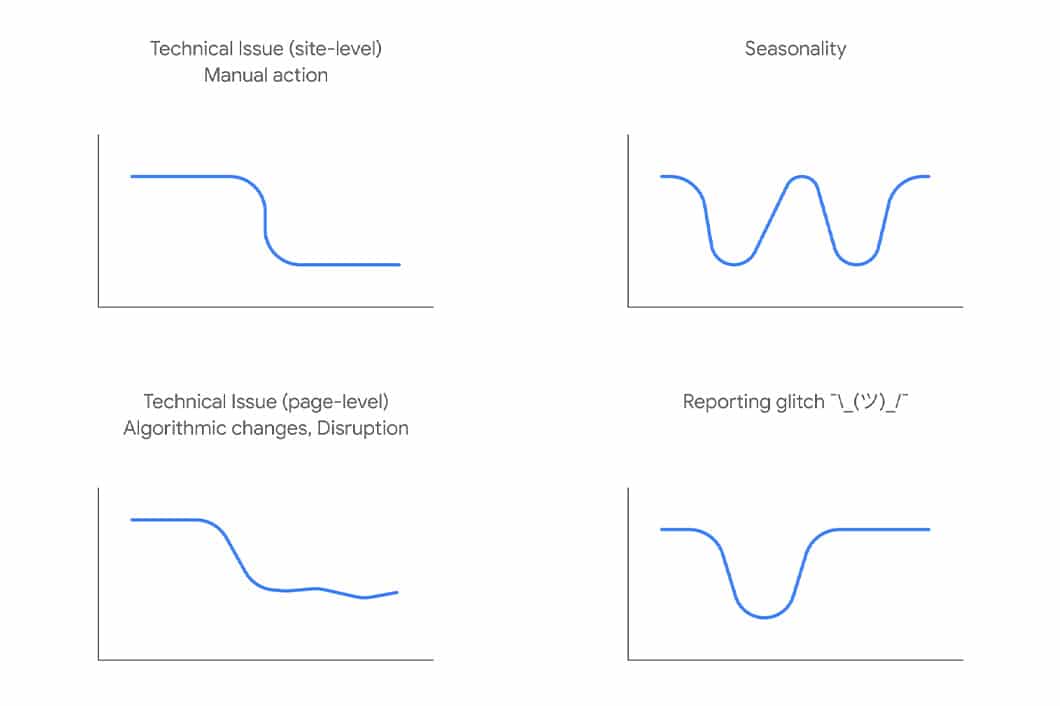
Here are the top 10 reasons your website dropped off Google and how to determine if it’s the cause of your traffic issue.
1. Algorithm Changes
Google updates its algorithm all the time. Google’s algorithm is how it decides which results to show users for search queries. Basically, it’s the scorecard Google uses to determine how highly your website will rank.
Small updates are largely rumors, but larger ones are officially announced by Google, such as the recent June 2021 “Page Experience Update.” This update offers higher rankings to pages that perform well for 3 key ranking signals: loading speed, usability (measured by time to first user input) and design stability.
The point is: Sometimes Google changes things that could impact your rankings and it’s out of your control.
But what is in your control is updating your site to perform the best it can for the new update. For example, now is a good time to optimize your page speed and review your web design to make sure it’s responsive and easy-to-use.
2. Missing or Removed Redirects
A redirect is a piece of code that does what it says — redirects — visitors from an old uniform resource locator (URL) to a new one. The most common is a 301 redirect, also known as a permanent redirect. Permanence is important because it tells Google a page has moved and to apply all your old ranking data to the new page.
If a redirect is missing, your new page will lose its history and you’ll see a big SEO ranking drop.
For this reason, you should keep a list somewhere of all your active redirects. Even a text file is fine. If you notice a specific page’s traffic drops, test out its redirect by pasting the old URL into your browser. If it doesn’t redirect to the new page, you know to add that redirect back in.
Redirects are usually created in your website’s .htaccess file, which looks like this:
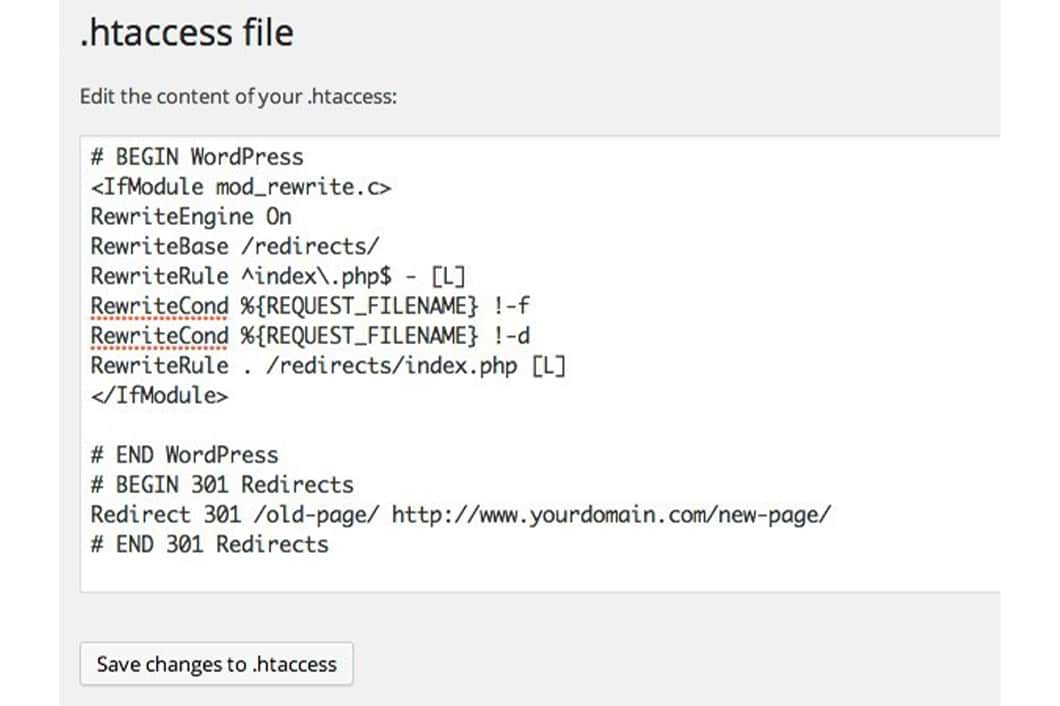
Alternately, some website platforms have plugins or settings areas where you can specify redirects, such as this WordPress plugin:
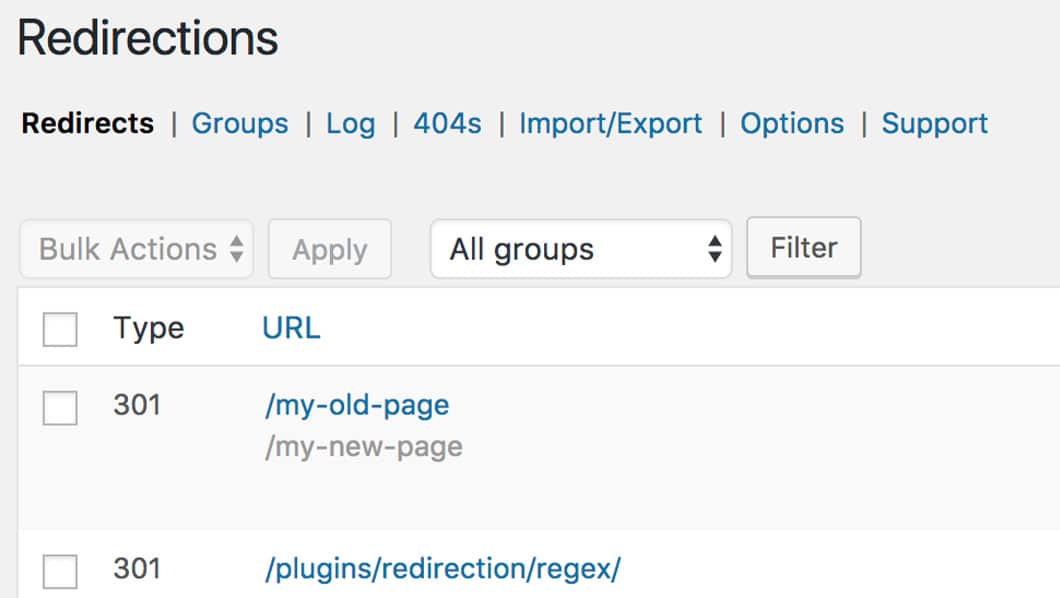
3. High Number of Spam Links
Spammy links are one of the top reasons Google rankings drop. In the early days of Google, it was easy to rank highly if you were able to build backlinks. Backlinks are other websites that link to yours. Quantity was the ranking factor, not quality.
Over the years, Google has become much more sophisticated. The algorithm not only differentiates legitimate backlinks from spam ones, but also penalizes websites that have spam backlinks.
Typically, this happens when Google detects a lot of low-quality backlinks. “Low quality” meaning from websites that are either fake, contain illegal or plagiarized content or are otherwise in Google’s bad books.
To see if this is affecting your website, run a backlink audit. There are many tools available for this, such as Moz and Ahrefs. If you detect spam links, remove them with Google’s free Disavow tool. It doesn’t stop the website from linking to you but it tells Google you aren’t associated with them.
Even with disavowing spam links, it can be difficult to recover SEO rankings caused by spam links. It’s important to not engage in “black hat SEO” tactics such as buying links. Also,o be careful who you hire for marketing to ensure they aren’t using these practices on your behalf.
4. Duplicate Content
Duplicate content can either be things you’re using repeatedly on your own website, or even content that looks too similar to someone else’s. Google treats this as plagiarism and gives it the same mark a college professor would: Fail.
Often it’s unintentional. A study from SEO app Raven estimates 29% of the internet is duplicate content.
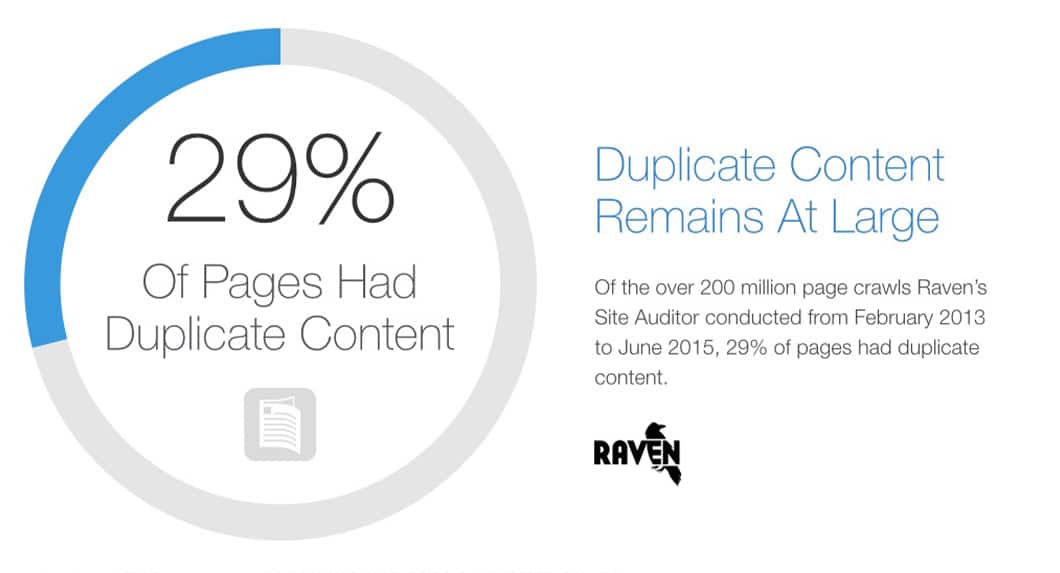
Moz has a good explanation of ways your website may be creating duplicate pages without you even realizing, and how to fix it with 301 redirects.
5. Keyword Stuffing and Over-Optimizing
Google knows when you’re trying too hard.
Yes, you should do SEO keyword research and add those into your content. Plus, you should be optimizing for other key SEO ranking factors, such as adding alt tags to your images, making your page URLs SEO-friendly and more.
Similar to link building, adding a ton of keywords used to get you to the top of Google search results. It was all about quantity. Now, it’s a surefire way to end up on the last page.
You might be wondering how to tell if you’re using too many keywords. There isn’t a hard rule, but most experts, such as HubSpot, advise adding your keyword in 4 – 5 places on your page:
- Title
- URL
- Meta description
- At least 1 heading
- At least once in the body content
Make your main keyword a long-tail one versus a short, generic one. Long-tail means a longer phrase, such as “how to get the highest rank on Google” instead of, “rank Google.”
As for over-optimizing, it becomes obvious quickly, such as in the example below. Write your content naturally with human readers in mind instead of machines and you’ll be fine.

6. Disconnected Tracking Code
This is a simple, but common, issue. A website update or user error can cause your Google Analytics, or other tracking code, to be accidentally removed. This is an obvious error as your website will report zero traffic at all.
You can check the status of your connection by logging into Google Analytics. Click on “Admin,” then “Tracking Info,” under the Property tab.
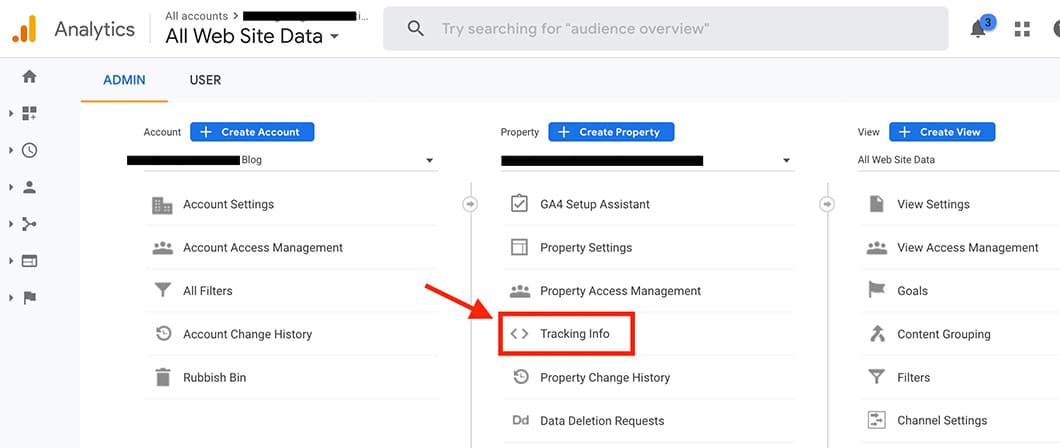
Clicking on “Tracking Code,” will display the current status. If it’s disconnected, it will say it’s not receiving data.

7. Improper Launch of a New Website
This one goes back to our old friends, 301 redirects. As discussed earlier, adding a redirect transfers all the SEO history from an old webpage to the new version.
It’s important to do 301 redirects every time you’re changing the location (URL) of a page, either by transferring it to a new domain or through a website restructure or redesign.
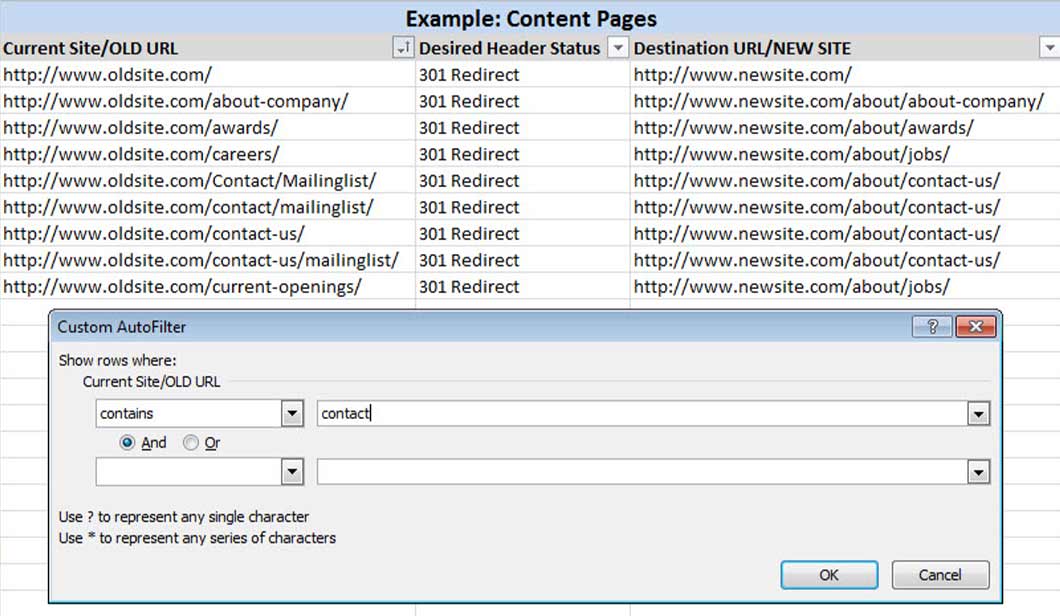
8. Slow Loading Speed
Loading speed is a major reason your SEO ranking could drop. Google defines a page load speed of less than 3 seconds as a best practice.
If yours takes longer, it’s costing you both ranking position and money. A study by Portent found conversion rates dropped significantly the longer a website takes to load.
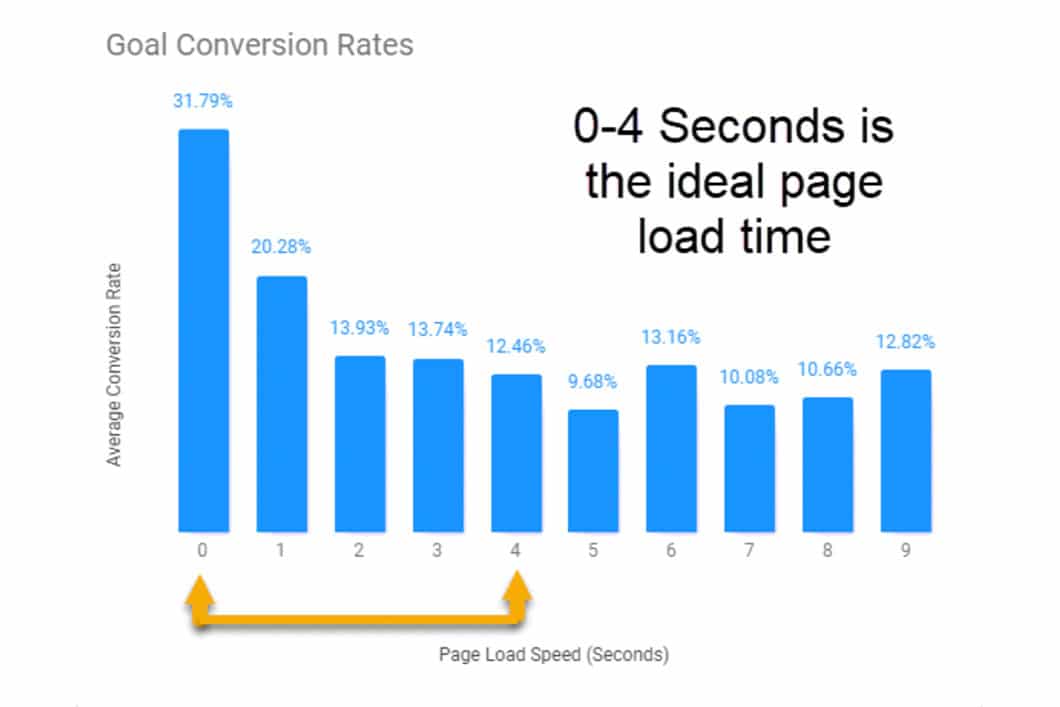
Test your loading speed regularly with tools such as Pingdom or Google’s PageSpeed Insights. They’ll give you tips to optimize your website.
9. More Competitive Content
Sometimes the reason your website dropped off Google isn’t because of anything you did, but rather something you didn’t do.
And that would be: Outsmarting your competition.
SEO rankings can naturally fall if one of your competitors creates better content than you. “Better” is a subjective term, but in terms of SEO rankings, it means their page or article is more thorough and more optimized than your version. This includes everything from the quality of the writing to keyword usage and page speed.
Keep an eye on your competition. Update your content regularly to keep it top-of-the-line.
10. GDPR Cookie Exclusions
The General Data Protection Regulation (GDPR) went into effect in May 2018 and can drastically affect your traffic. The privacy compliance legislation requires every website to ask visitors from European Union countries to opt-in to accepting cookies, which is what analytics tracking relies on. If they opt-out, their data isn’t collected.
If many EU visitors opt-out, your traffic will appear to have dropped because those visitors will be invisible.
Likewise, this can also happen if your website isn’t configured correctly. SEO agency The Gray Dot reported a simple technical glitch with cookie permissions resulted in one of their clients “losing” 95% of its EU traffic.
How to Stop Your Website Losing Traffic
These are the 10 most common reasons for a sudden SEO ranking drop. Make a point of reviewing your website monthly for errors such as these.
You don’t need fancy software to stay on top of your SEO, but you should sign up for Google Search Console. It can alert you to technical issues.
Your content marketing strategy is always a working document. That includes your SEO optimization, too. Stay informed of Google algorithm changes and the best practices to avoid your Google rankings dropping out of the blue.




